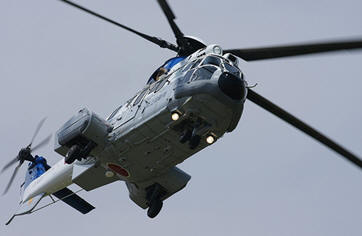|
They added that the M.P (main pressure), MGB.T (main
gearbox oil temperature) and the S/B.P (standby oil pump
pressure) captions on the Vehicle Management System
(VMS) also illuminated and the main gearbox oil pressure
indicated zero. The MGB.P (main gear box oil pressure)
caption then illuminated on the CWP. The crew actioned
the ‘Total Loss of MGB (Main Gear Box)Oil Pressure’
checklist, which required the activation of the MGB
emergency lubrication system (EMLUB).
However, within a minute the MGB EMLUB caption
illuminated on the CWP indicating that the emergency
lubrication system had failed. As a result of the MGB
EMLUB caption illuminating, the crew carried out the
‘Emergency Landing – Power ON’ checklist and
successfully ditched the helicopter in the sea, close to
a ship. The passengers and crew evacuated the helicopter
and boarded two life rafts before being rescued and
transported to the ship. There were no reported
injuries.
The helicopter has been recovered from the sea and
transported to Aberdeen for examination. The Digital
Voice and Data Recorder (DVDR) and other items of
avionics had been removed and transported to Farnborough
for analysis. The AAIB dispatched a team of
investigators and support staff to Aberdeen.
The main gearbox lubrication system includes two
mechanically-driven oil pumps and a crew-activated
emergency lubrication system. The gearbox normally
contains 22 litres of oil. The oil pumps (a main pump
and a standby pump) are driven by the oil pump drive
pinion located on the lower part of the bevel gear
vertical shaft within the main gearbox. Vertical shafts
of this type are fitted to all EC225 and some AS332 L1
and L2 helicopters. The bevel gear vertical shaft is
manufactured from two sections welded together. The
emergency lubrication system includes an 11 litre tank,
containing a mixture of glycol and water (Hydrosafe
620), and an electric pump. When activated, Hydrosafe
620 is pumped into a distributor, mixed with engine
bleed air, and sprayed into the main gearbox. The spray
is designed to provide a minimum of 30 minutes of main
gearbox cooling and lubrication in the event of total
loss of oil lubrication. The MGB EMLUB caption
illuminates if the system fails.
Vibration data prior to the accident flight was examined
and the vibration signatures known as the MOD 45
indicator, which monitors the meshing frequency of the
bevel gear and the MOD 70 indicator, which monitors the
meshing frequency of the oil pump wheels, show some
exceedances. These two indicators each have two alert
thresholds; a lower threshold designated AMBER, and a
higher threshold designated RED.
During the first two sectors, on Monday 22 October, the
helicopter flew for approximately 3 hours 50 minutes.
During the first sector, the MOD 45 indicator showed an
increasing trend that then exceeded the AMBER trigger
threshold followed, later during that sector, by an
exceedance of the RED threshold. During the second
sector three further data points were recorded, all
above the RED threshold and increasing in magnitude. The
MOD 70 data showed one exceedance; a value in excess of
the RED threshold which occurred during the second
sector at the same time as the final MOD 45 point.
Indicators Kg and Kr, which are also associated with the
bevel shaft and wheels, also showed increasing trends
and exceeded their AMBER thresholds.
Preliminary engineering investigation - the main gearbox
was drained. An initial visual examination has
identified a 360 degree circumferential crack on the
bevel gear vertical shaft, in the vicinity of the weld
that joins two sections of the shaft. Therefore, the
main and standby oil pump gears were no longer being
driven.
Related incident - On May 10, 2012 there was an accident
to an EC225 LP (G-REDW) in which the bevel gear vertical
shaft failed. That investigation is ongoing and the
manufacturer issued a Service Bulletin, which was
subsequently mandated by Airworthiness Directive (AD
2012-0115E) and contained requirements applicable to EC
225 LP.
|



